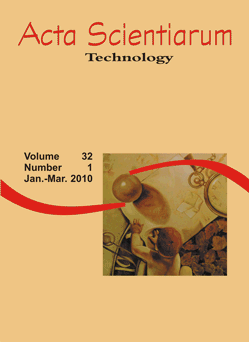<b>Impregnation of composite from polycarbonate (PC) and silica gel (Si) films with photochromic dye in supercritical fluid</b> - DOI: 10.4025/actascitechnol.v32i1.1999
DOI:
https://doi.org/10.4025/actascitechnol.v32i1.1999Keywords:
composites, polycarbonate, silica gel, impregnation, supercritical fluidAbstract
The aim of this work was to study the impregnation of the photochromic dye Reversacol Graphit® in composite films of polycarbonate (PC) and silica gel, with the purpose of finding applications in photochromic lenses. Pure PC films were also impregnated in the same conditions, to verify the effect of the silica-gel addition. The composites films were produced in Si:PC ratios of 1:40 and 1:80 (m m-1), using the casting method . For the impregnation of the dye Reversacol Graphit® in the obtained films, the supercritical process was used due to its efficiency and benefits. The impregnation was made in the times of 15, 30, 45, 60, 90, 120, 150 and 180 minutes. The adopted temperature and pressure were 60ºC and 120 bar, respectively. The amount of pigment impregnated in Si:PC films - 1:40 and 1:80 (m m-1) was 29 and 23% of dye mass per composite mass, respectively, and for pure PC film it was only 2.2% dye mass per composite mass. From the thermal analyses, it was verified that the composite films presented greater thermal stability. From the technique of electronic microscopy, it was observed that pure PC films and the composites Si:PC - 1:40 and 1:80 (m m-1) presented a smooth and homogeneous surface.Downloads
Download data is not yet available.
Downloads
Published
2009-11-13
How to Cite
Lima, F. de A. F. de, Santos, O. A. A., & Pinheiro, N. (2009). <b>Impregnation of composite from polycarbonate (PC) and silica gel (Si) films with photochromic dye in supercritical fluid</b> - DOI: 10.4025/actascitechnol.v32i1.1999. Acta Scientiarum. Technology, 32(1), 69–74. https://doi.org/10.4025/actascitechnol.v32i1.1999
Issue
Section
Chemical Engineering
License
DECLARATION OF ORIGINALITY AND COPYRIGHTS
I Declare that current article is original and has not been submitted for publication, in part or in whole, to any other national or international journal.
The copyrights belong exclusively to the authors. Published content is licensed under Creative Commons Attribution 4.0 (CC BY 4.0) guidelines, which allows sharing (copy and distribution of the material in any medium or format) and adaptation (remix, transform, and build upon the material) for any purpose, even commercially, under the terms of attribution.
Read this link for further information on how to use CC BY 4.0 properly.











8.png)




